 |
NEW ZEALAND
Vertigo releases from
New Zealand are somewhat puzzling. The first few releases of the
British counterparts were on Fontana. Colosseum's Valentyne Suite was for instance
released as Fontana VTY 847900. A lot of the later British albums were
released on Vertigo here too, but much of the elaborate packaging was
lost, a
prime example being 6360 043, Tudor Lodge's self titled LP. The complex
gimmix cover and texture was completely discarded and rendered into a
''normal'' single cover (with flipback). Another example is 6360 014, Juicy Lucy's Lie Back And Enjoy It,
which lost its poster cover, but got at least a fold-out cover with the
portraits allocated to the back cover. Otherwise none of these releases
seem
interestingly
different enough to
be included here. If gatefold covers were applied, they were ''New
Zealand style'', with the opening at the inside of the sleeve. There
were, however, some very unexpected releases
too, that are unique to this country. One native singer was signed, one
German album was released and some LP's were licensed from Island (even
though there are albums on Island in New Zealand too). In the singles
department this branch may have had some more freedom and the native
singles
we could get hold of are on display at the bottom, as usual.
New Zealand albums have B-side styled labels on both sides (see scans below). The font of the perimeter text on the label is characteristic enough to identify a record as manufactured in New Zealand. Matrix numbers can be both machine-stamped and hand-etched. There is no mentioning of the country of origin on the label to be found. There is a notice, however, on the cover either with a logo (see scan) or else just in print. We present the albums in numerical order.
New Zealand albums have B-side styled labels on both sides (see scans below). The font of the perimeter text on the label is characteristic enough to identify a record as manufactured in New Zealand. Matrix numbers can be both machine-stamped and hand-etched. There is no mentioning of the country of origin on the label to be found. There is a notice, however, on the cover either with a logo (see scan) or else just in print. We present the albums in numerical order.
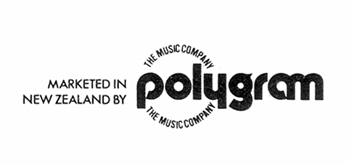 |
ALBUMS
5847
901
JUICY LUCY - ''same'' (1969)
JUICY LUCY - ''same'' (1969)
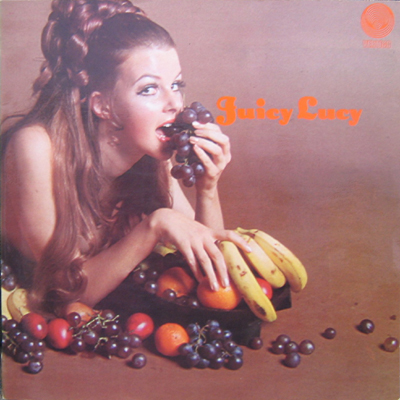 |
 |
|
The Vertigo logo on front is red. Matrix number A-side:
847901 VO / 2Y A//1 420 1 Matrix number B-side:
847901 *** 2Y //2 420 1 Second side very difficult to read.... Rarity scale: R3
|
|
The musical contents are identical to
the UK release.
Another variation on the theme of Eve, this time she is definitely female. On the back of the sleeves she even has the nerve to pose without knickers! Quite different from, say, the Spanish release!
Another variation on the theme of Eve, this time she is definitely female. On the back of the sleeves she even has the nerve to pose without knickers! Quite different from, say, the Spanish release!
5847 903
BLACK SABBATH - ''same'' (1969)
Apart from the different catalogue number, the differences with the UK release are inconsequential.
6360 600
LUCIFER'S FRIEND - ''same'' (1970)
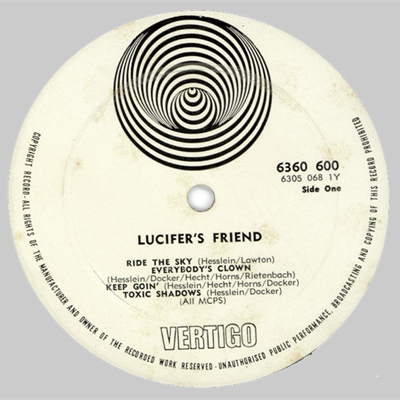 |
Surprise, surprise! Even the first
Lucifer's Friend album is available on Vertigo swirl, complete with
German catalogue number. Only in New Zealand, though!
6360
601
FRUMPY - ALL WILL BE CHANGED (1970)
FRUMPY - ALL WILL BE CHANGED (1970)
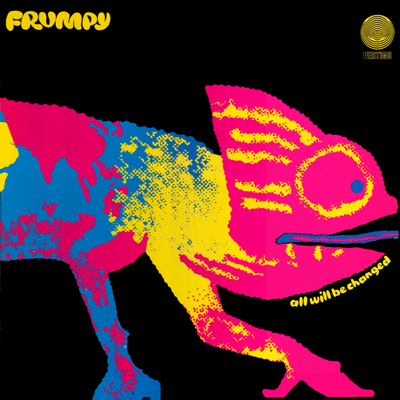 |
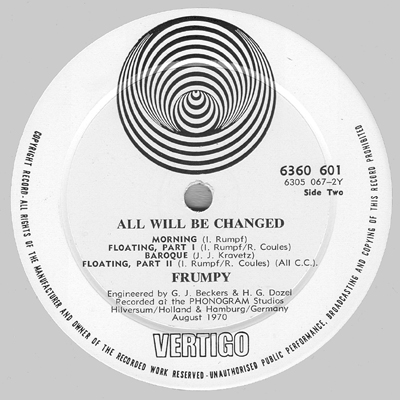 |
|
Line-up: Carsten Bohn, dr/
Jean-Jacques Kravetz, keyb, sax/
Inga Rumpf, voc, gtr/ Karl-Heinz Schott, bsgtr.
Production: Rainer
Goltermann.
Cover-design by unknown.
Liner notes: none.
Cover manufactured by unknown. Recorded at Phonogram Studios, Netherlands. Track listing A-side: Life
Without Pain
(Inga Rumpf + R.Coules) 3'45''/ Rosalie Part I (Inga Rumpf) 5'54''/
Otium (Jean-Jeaques Kravetz) 4'23''/ Rosalie Part II (Inga Rumpf)
4'10''/ Indian Rope Man (Ritchie Havens) 3'17''.
Track listing B-side:
Morning (Inga Rumpf) 3'20''/ Floating Part I (Inga Rumpf + R.Coules)
7'33''/ Baroque (Jean-Jeaques Kravetz) 7'33''/ Floating Part II (Inga
Rumpf + R.Coules) 1'23''.
The Vertigo logo on front is yellow. Matrix number A-side:
10 AA 6305067 1Y 320 Matrix number B-side:
10 AA 6305067 2Y 320 These are German matrix numbers in a German font, including that country's code, 320. They are machine-stamped. Rarity scale: R3
|
|
First album of this band, that
struggles on this release with rather disparate interests and has
difficulty to blend them into a meaningful musical unity. The single Life without pain tries to be
commercial soul-rock, expertly executed but very predictable. The
bluesy ballad Rosalie is
monotonous and bleak, but almost saved by the great vocal performance
of Rumpf. Otium raises a
hectic atmosphere with flashy organ riffs, while the Ritchie Havens
cover Indian rope man sounds
competent, but not very exciting. Side B is completely different. Morning adds carloads of percussion
but fails to swing anyway. Floating
is suddenly quite experimental, especially the organ parts, and even
incorporates a reasonably palatable drumsolo. Baroque makes use of strongly
dissonant progressions at first, but ends on a doubtful beefed-up note.
Still a long way to go, the album at least attempts at a sound of its
own. There are no electric guitars on the record!
The inventive op-art gimmix sleeve that
was fitted over the cover proper (in Germany, that is) has been
discarded. Instead, just the gatefold cover survived, which is
nice enough in itself and needs no comment. Inside the gatefold the
black and white wave-lines are difficult to appreciate without the
gimmix outer sleeve.
The lettering nicely evokes a
''reptilian'' impression, very fitting and properly placed too.
Notes: This was released in Germany on Philips (6305 067, which is also the matrix for the NZ issue) in 1970.
Notes: This was released in Germany on Philips (6305 067, which is also the matrix for the NZ issue) in 1970.
6360
900
LINDSAY MARKS - ''same'' (1973)
LINDSAY MARKS - ''same'' (1973)
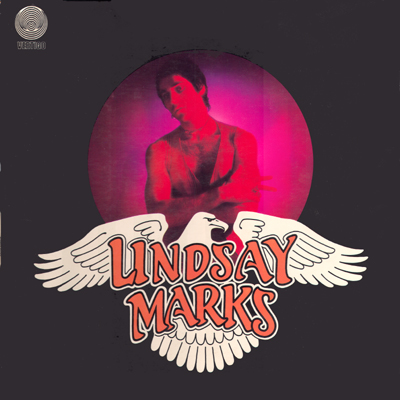 |
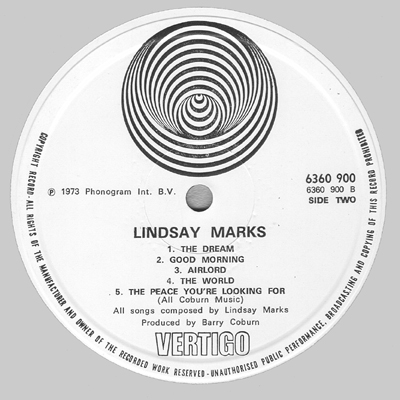 |
|
Line-up: Ricky Ball, dr/
Barry Coburn, sax, keyb, xyl/ Miles Golding, vl/ Eddie Hansen, gtr/
Robert Hooper-Smith, keyb/ Bruce Lynch, cb/ Peter Madill, cl/ Lindsay
Marks, voc, gtr, trp/ Leone Toms, fl/ Philip Toms, gtr/ Paul
Woolwright, bsgtr.
Production: Barry Coburn +
Robert Raymond.
Cover-art by Warren Wilson (backcover). Cover-design by Kenneth
Beatson.
Photography by Philip Peacocke. Liner notes: none.
Cover manufactured by unknown. Recorded at Stebbing Studios, Auckland. Track listing A-side: Son
Of The Sun/ One More Time/ Candy Words/ Sad Girl/ Manhunter/ Family.
Track listing B-side: The
Dream/ Good Morning/ Airlord/ The World/ The Peace You're Looking For.
All tracks by Lindsay Marks. The Vertigo logo on front is white. There are no running time indications. Matrix number A-side:
6336900 A (wrong and machine-stamped) Matrix number B-side:
6336900 2 (also wrong and hand-etched) Rarity scale: R4
|
|
The inhospitable mix of Jim Croce, Cat
Stevens and Barry Ryan that adorns these sides would not interest
anyone in 2007, I guess, but it is a very rare swirl record
nonetheless. The backing band is nearly brilliant, though. Poetic flute
parts, driving percussion. sparkling guitars, it's all there. But no
amount of inspired backing can salvage anything worthwhile from these
overly common songs that lack any feature that would elevate them above
the mediocre. Only the beginning of the B-side is somewhat less barren.
The dream even is a nice song
(with a fabulous arrangement) and Airlord
at least isn't downright discardable. Otherwise, give this a wide berth.
The front cover is a great example of
unprofessional graphical designing, but without the charm that such
efforts can have. Heraldic eagle and soft-cell photograph are not
integrated in any way, except through both being placed centered. The
colours are grisly too. Luckily the backcover is a surrealistic
pen-drawing of hordes of people who climb a gigantic eagle. Quite
discomfiting. There is an insert with the (terrible) lyrics that is
made of textured paper and that boasts scorchingly pink clouds as well.
The lettering neither blends with the
photo, nor agrees with the severe style of the heraldic animal. What a
mess!
ILPS
9111
KING CRIMSON - IN THE COURT OF THE CRIMSON KING (undated)
KING CRIMSON - IN THE COURT OF THE CRIMSON KING (undated)
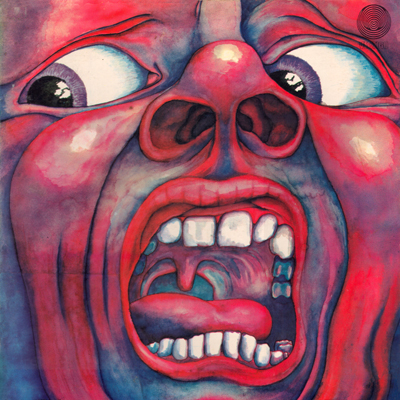 |
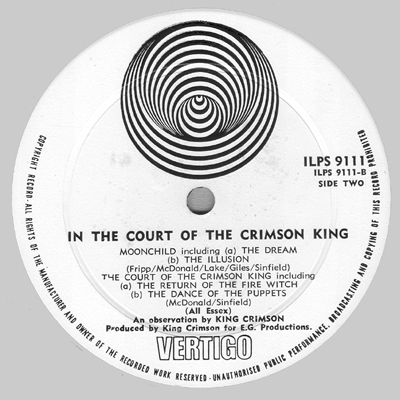 |
|
Line-up: Robert Fripp, gtr/
Michael Giles, voc, dr/ Greg Lake, voc, bsgtr/ Ian McDonald, fl, ob,
cl, keyb, vibr, voc.
Production: King Crimson.
Cover-art by Barry Godber. Liner notes: none.
Cover manufactured by unknown. Recorded at Wessex Sound Studios, London. Track listing A-side: 21st
Century Schizoid Man [including Mirrors] (King Crimson + Peter
Sinfield) 6'52''/ I Talk To The Wind (Ian McDonald + Peter Sinfield)
5'40''/ Epitaph [including March For No Reason and Tomorrow And
Tomorrow] (King Crimson + Pete Sinfield) 8'30'' .
Track listing B-side:
Moonchild [Including The Dream and The Illusion] (King Crimson + Pete
Sinfield) 12'09''/ The Court Of The Crimson King [including The Return
Of The Fire Witch and The Dance Of The Puppets] (Ian McDonald + Peter
Sinfield) 8'48''.
The Vertigo logo on front is black. Matrix number A-side:
ILPS 9111 A//3 1 3 Matrix number B-side:
ILPS 9111 B//2 1 7 These are machine-stamped. Rarity
scale: R3
|
|
After relistening to the predecessor
band Giles, Giles & Fripp with its uneasy mixture of Bonzo Dog Band
antics and finely honed 60's guitar pop, it is ever so enigmatic how
this here
album could have emerged from the ashes of that particular band.
''Court'' is one of very few genre-defining records. In fact the album
sets standards for ''prog-rock'' that are not easy to equal, even less
so to surpass. Issued in 1969 (!) in the UK, there is so much that is
really new here that any concise listing (like this one) of those
features must fail to do justice to the music. Extreme dynamic
differences
between blatantly loud and whisperingly quiet are introduced in rock
for the first time here and to great effect. Technically the record is
brilliantly played, but not one single time is this detrimental to the
music's expressivity. Later prog bands often sinned against this. The
guitar of Fripp is recognizable out of millions: an integration of
dishearteningly fast and dissonant notes with passages suddenly
long-sounding and
fluent. Also the woodwinds are treated in a new way and establish a
conglomerate of cold jazz (not cool!), avant-garde and ''organized
chaos'', as Fripp expresses himself. McDonald plays every note with
feeling and confidence and also contributes the washes of mellotron
that characterizes much of the sound. Lake sings sensitively and plays
a fine and inventive bass-line, Giles is a drummer far above average in
rock. The
well-known opening blends hard-rock with lush mellotron and heavy
woodwinds (really!) with a blazing guitar solo. Its unfriendly
angularity and general threatening atmosphere notwithstanding it even
seemed accessible enough to have been projected as a single (that never
came out). Futuristic in its litteral meaning, this still sounds fresh
and urgent in 2007. The contrast to the following I talk to the wind is stunning.
Here is a peaceful oasis with a superb flute-part that soothes the soul
and at the end blends into late-night jazz with excellent multi-part
vocals. The long Epitaph
starts deludingly placent, but soon turns out to be so only on the
surface. Underneath an ominous menace is omnipresent. Knowledge is a deadly friend/ If no one
sets the rules/ The fate of all mankind I see/ In the hands of fools.
This textual example still rings true after almost 40 years. Side B
starts with the picturesque Moonchild,
a lesson in gossamer treatment of atmospheric elements. The second half
almost comes to a complete standstill and trails off into near silence.
The title track is a complex combination of all previous modules. Huge
waves of mellotron, lyrical woodwinds, intimidating rhythms, unexpected
compository built-ups with many layers and noble guitar-parts are just
some of the feautures. The lyrics are cryptic, but very suggestive.
This
album may be considered as the flagship of early prog and still holds
its ground as of today.
It is to be admired, that the cover
matches the sounds within. It's one of those rare images that stick to
the brain even after viewing it only once. A human face, distorted by
fear and anxiety looms large, its emotions too big to fit completely on
the cover. Nose and mouth are wide open, revealing grottos that suggest
other worlds within worlds. Folded open, the picture continues.
Through the repetition of the cheek-bone the face extends into a
landscape. The ear stands off into an azure cosmos where distant
planets
float along. Also the inside is memorable. A moon with a benign face
and two sharp incisors makes a narrative gesture. Red planets orbit him
everywhere. The very readable lyrics are printed in white lettering on
the left of the gatefold. Top-notch. Only negative point: the colours
have been very unfaithfully reproduced.
There is no lettering to interfere with
the image (but the Vertigo logo does, unfortunately). A very wise
decision.
ILPS
9127
KING CRIMSON - IN THE WAKE OF POSEIDON (undated)
KING CRIMSON - IN THE WAKE OF POSEIDON (undated)
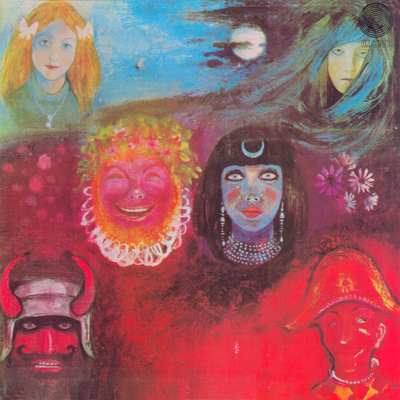 |
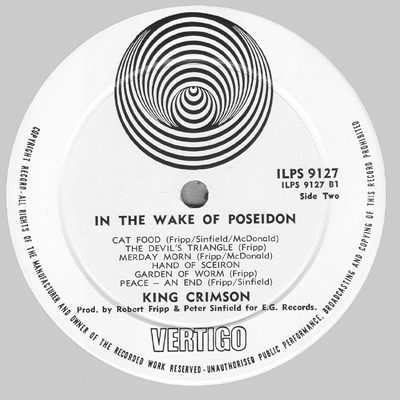 |
|
Line-up: Mel Collins, fl,
sax/ Robert Fripp, gtr, keyb/
Michael Giles, voc, dr/ Peter Giles, bsgtr/ Gordon Haskell, voc/ Keith
Tippet, keyb.
Production: Robert Fripp +
Peter Sinfield.
Cover-art by Tammo de Jongh (outside) + Peter Sinfield (inside). Liner notes: none.
Cover manufactured by unknown. Recorded at Wessex Sound Studios, London. Track listing A-side: Peace
- A Beginning (Robert Fripp + Peter Sinfield)/ Pictures Of A City
[including 42nd At Treadmill] (Robert Fripp + Peter Sinfield)/ Cadence
& Cascade (Robert Fripp + Peter Sinfield)/ In The Wake Of Poseidon
[including Libra's Theme] (Robert Fripp + Peter Sinfield).
Track listing B-side: Cat
Food (Robert Fripp + Peter Sinfield + Ian McDonald)/ The Devil's
Triangle (Robert Fripp)/ Merday Morn (Robert Fripp + Ian McDonald)/
Hand Of Sceiron (Robert Fripp)/ Peace - An End (Robert Fripp + Peter
Sinfield).
The Vertigo logo on front is black. There are no running time indications. Matrix number A-side:
ILPS + 9127 + A2 Matrix number B-side:
ILPS + 9127 + B2 These are machine-stamped. Rarity scale: R3
|
|
How to move on without Lake and
McDonald, who both had a representative role in the sound of the debut
LP? And how to follow up a record like the previous one musically? The
answer is
thought by many not to be wholly satisfactory, as this here album is
often seen as a weak brother of the first. Fripp now plays the
characteristic mellotron himself (without any discernable difficulty)
and Collins is the new woodwinds miracle, not less enticing than
McDonald was. The weak point must be the vocals. Haskell's voice is
severely limited and does not always credit to the emotions that he is
asked to express. It may be true, that no real new points of view are
presented within this album, but they are definitely further developed
to at times majestic results. The fragile start of Peace - a beginning contrasts again
heavily with Pictures of a city,
where the menace now has become apocalyptic. The middle piece of that
track is so transparant, that it is hardly music anymore: ethereal webs
of sound that drift along. There are more complicated means necessary
to achieve this ever expanding contrast. More asymmetrical
time-signatures, more measure-changes, more complicated riffs, often
played unisono to reinforce them. The tranquil Cadence & cascade shows the
disadvantages of Haskell's wobbly voice very clearly. The overwhelming
title track pulls all stops. Fripps solo on acoustic guitar is
immediately recognizable and mellotron waves hurl their depths over
your head as if they want to drown you. Maybe the lyrics are a shade
too mystical for their own good. Side B starts off with the almost
accessible Cat food, a bitter
observation of
consumer's paradise, adorned with the freakiest grand piano imaginable.
Never need to
worry/ With a tin of Hurri Curri, no indeed. The strongest track
must be the three-part suite that follows, an exalted mixture of heavy
rock, free-jazz and 20th century chamber-music with an exceptionally
calamitous atmosphere. This track seems quite unsuitable to hear just
before
falling asleep. Cataclysmic shreds of music, sharp and incisive
industrial soundscapes, shrieking dissonants, uncanny instrumental
combinations and small morsels of innocent music that perish in the
violence, these are hard ingredients to digest, but simultaneously very
adventurous and uncommon listening. This is music that suggests the
very end of times in a credible way, much like some episodes in the
symphonies of Arthur Honegger do. More difficult to get acquainted with
than the first album, nevertheless an excellent effort in its own right.
''Twelve archetypes'' inhabit the
cover, painted with not too much skill, but with a reasonable amount of
credulity to make up for this. The Vertigo logo is placed at the least
disturbing spot, but still impeding the image's integrity. The texture
of the British cover has been deleted, but the laminated surface has
some vague kind of texture of its own. The inside shows the lyrics to
the right and a colourful abstraction of blue and green.
Again there is no lettering to
interfere with
the image, a fact we have heaped our praise upon already above.
ILPS
9141
KING CRIMSON - LIZARD (undated)
KING CRIMSON - LIZARD (undated)
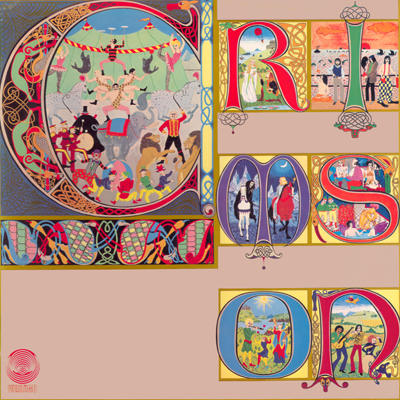 |
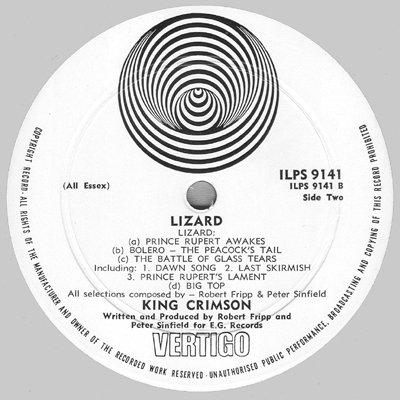 |
|
Line-up: Jon Anderson, voc/
Mike Charig, crnt/ Mel Collins, fl, sax/ Nick Evans, trb/ Robert Fripp,
gtr, keyb, dr/ Gordon Haskell, voc, bsgtr/ Andy McCullogh, dr/ Robin
Miller, ob/ Keith Tippet, keyb.
Production: Robert Fripp +
Peter Sinfield.
Cover-art by Gini Barris. Liner notes: none.
Cover manufactured by unknown. Recorded at Wessex Sound Studios, London. Track listing A-side:
Cirkus [including Entry Of The Chameleons]/ Indoor Games/ Happy Family/
Lady Of The Dancing Water.
Track listing B-side:
Lizard a) Prince Rupert Awakes b) Bolero - The Peacock's Tale c)
The Battle Of Glass Tears [including 1. Dawn Song 2. Last Skirmish 3.
Prince Rupert's Lament] d) Big Top
All tracks by Robert Fripp + Peter Sinfield. The Vertigo logo on front is red. There are no running time indications. Matrix number A-side:
ILPS 9141 A 700 Matrix number B-side:
ILPS 9141 B 700 These are machine-stamped. Perhaps ''700'' is a country code for New Zealand? Rarity scale: R3
|
|
The Giles brothers have left to join
McDonald, but no big loss, as McCullogh is a worthy replacement at the
skins and Haskell handles his bassguitar better than he does his own
vocal chords. The enlarged woodwinds and brass sections seem
to suggest jazz, and although this is true in some way, the results are
thoroughly unexpected. This record was not received very well and it's
easy to see why, though almost 40 years later these objections have
largely
evaporated. Undoubtedly this album is even less accessible than the
previous one. The music now betrays psychiatric tendencies, as well as
delusions of grandeur, but does so with verve and conviction. Grotesque
subject matter reigns supreme. Already on Cirkus the amount of sudden
harmonic eruptions and atmospheric twists borders on the insane. The
lyrics evoke a dense nightmare like: Worship
cried the clown, I am a TV. At the end of the track the music is
abandoned for sheer chaos and destruction. Indoor games also balances
precariously on the thin edge of the demented. Psychotic games are
being played like: Each afternoon
you train baboons to sing/ Or swim in purple perspex waterwings.
Biting woodwinds, derailed guitars and large fans of mellotron are just
(but only just) kept in control by the excellent composition. The
macabre laughing of a deranged human being ends the track. In Happy family mental health does not
improve. A row of totally flipped-out family members parades through
the song, musically designed with again extreme means. The very short
oasis Lady of the dancing water,
with its truly miraculous flute part, is almost unlikely placid after
all this
mental violence. If only Haskell would have sung this a little more
confidently. Side B presents a complicatedly structured suite, a model
kit that tries to assemble very different elements into a unity. Jon
Anderson of Yes sings the opening in his overclean style, but somehow
fits very well in this evocation of times long lost, not in a historic
sense, but more like the worlds of Tolkien do. Now Crimson suddenly
plays crystal clear pop-rock with hints of things lurking underneath.
This runs into The peacock's tale,
a never heard before concoction of bolero, wistful oboe, mellotron
hurricanes and extremely angular all-or-nothing jazz. Unique and
inventive. The battle of glass tears
is again King Crimson as we know it: apocalyptic almost-chaos and a
ruthless riff that induces panic. It discharges itself into a lonely
crying electric guitar that sounds like the voice of the last living
human, viewing utter destruction. Almost unbearable to really listen
to. The very end is taken up by a frolicking waltz that makes a
disheartening use of varispeed to produce another kind of nightmare:
that of failing senses in front of a world in dissolution. One of the
most extreme records to come out of rock country, it is easy to
understand its chequered reputation, but the unflinching listener can
dig up a lot of musical gold here.
The cover follows more or less the
Tolkien path: Celtic ornaments are combined with brightly coloured
images that suggest legend and myth. By looking carefully, the beholder
can distinguish scenes from the lyrics of almost all tracks. Some nice
touches are being applied. Rock historicians may marvel at the ''N'',
where a band consisting of Jimi Hendrix, Chris Wood and Ginger Baker is
in full action. Unfortunately Hendrix plays right-handed! Above them
Rupert flies along in a small aircraft. The ''I'' shows the Beatles
aboard on a ship at a sea full of idiosyncrasies. George
meditates, Paul poses worldly, John contemplates a ghost from a bottle
that is Yoko and Ringo wears a clown's costume. The inside has
unfortunately lost its colour. The lyrics are hardly readable on the
now grey background.
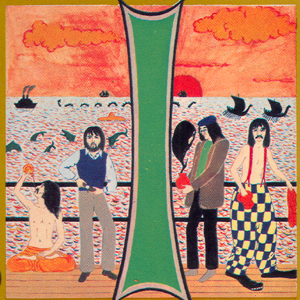 The Beatles' cameo appearance on the cover. |
The lettering is part of the image and
the image is part of the lettering. Excellent.
And
just for the record: the collectible albums by Dragon have never been
released with a swirl label.
As you would expect, New Zealand released cassettes too.
Below an example: Colosseum's Daughter Of Time.
We couldn't find any better scan yet.
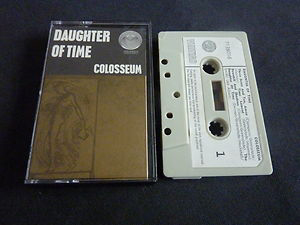 |
SINGLES
Some singles with local bands were
issued and some of British and German bands that were unique to New
Zealand. The following have been
confirmed (in numerical order):
6036 028 SHONA LAING
A: 19.05. B: There Are No Words [To Describe]
6036 900 TICKET
A: Mr.Music. B: Changes.
6036 902 SPLIT ENDS
A: For You. B: Split Ends.
(extremely rare debut single, since this is also sought after by Split Enz and Crowded House collectors) and sorry about the horrible scan, the best we could get , unfortunately.
6036 903 SHONA LAING
A: Show Your Love. B: Don't Expect Me To Be Your Friend.
6036 904 MANTIS
A: Time is tight. B: ?.
6036 905 SHONA LAING
A: Masquerade. B: If You Could Read My Mind.
(issued with special picture label, see scan).
6036 028 SHONA LAING
A: 19.05. B: There Are No Words [To Describe]
6036 900 TICKET
A: Mr.Music. B: Changes.
6036 902 SPLIT ENDS
A: For You. B: Split Ends.
(extremely rare debut single, since this is also sought after by Split Enz and Crowded House collectors) and sorry about the horrible scan, the best we could get , unfortunately.
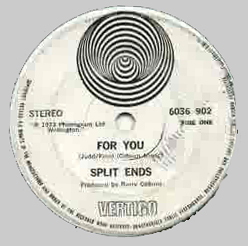 |
6036 903 SHONA LAING
A: Show Your Love. B: Don't Expect Me To Be Your Friend.
6036 904 MANTIS
A: Time is tight. B: ?.
6036 905 SHONA LAING
A: Masquerade. B: If You Could Read My Mind.
(issued with special picture label, see scan).
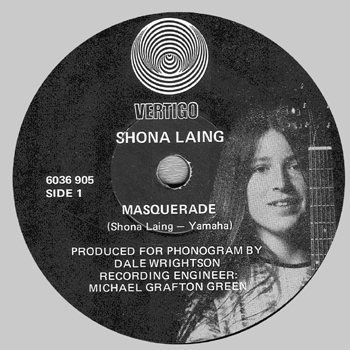 |
6036 906 SHONA LAING
A: Someone To Be With. B: Lady Dipton.
A: Someone To Be With. B: Lady Dipton.
6036 909 DRAGON
A: Education. B: Swell foot Sue.
6078 201 NAZARETH
A: This flight tonight. B: Called her name.
6078 201 NAZARETH
A: This flight tonight. B: Called her name.
6147 001 LUCIFER'S FRIEND
A: Ride the sky. B: Horla.
A: Ride the sky. B: Horla.
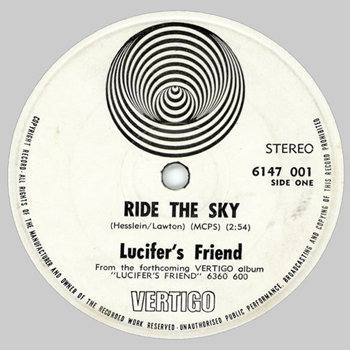 |
We sincerely hope that you will
be of assistance in making this information as reliable as possible.
In case of any contributions or questions or even complaints, please use this here virtual address: e-mail.
In case of any contributions or questions or even complaints, please use this here virtual address: e-mail.